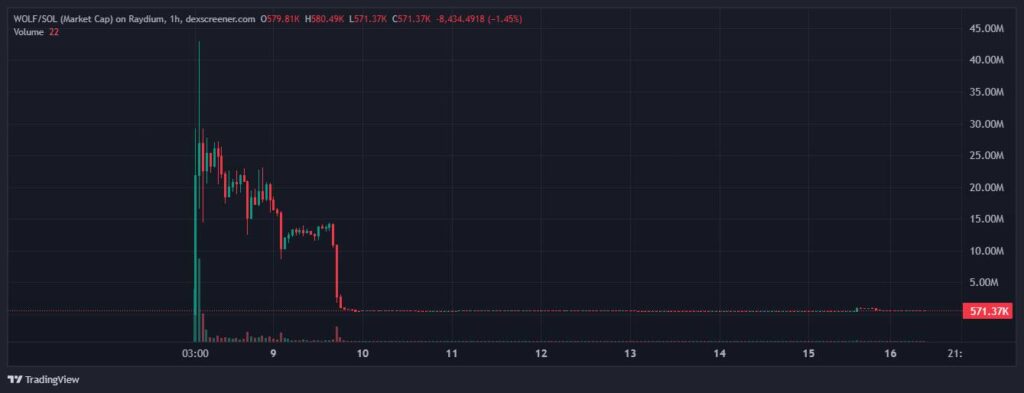The world of cryptocurrency is once again making headlines, as Hayden Davis, the co-creator of the controversial Libra token, has launched a new memecoin named Wolf (WOLF). This Memecoin, which hit the market on March 8, has already stirred speculation due to unsettling patterns reminiscent of insider trading that have previously marred Davis’ earlier projects. Much like its predecessor, the Libra token, which experienced a catastrophic collapse, the WOLF token is showing signs of potential trouble with an overwhelming 80% of its supply controlled by a single entity.
Following a peak market capitalization of million shortly after its introduction, the WOLF token has plummeted, losing over 99% of its value in a shockingly brief timeframe. Analysis by the blockchain insights platform Bubblemaps revealed that multiple wallets trace back to Davis, suggesting a concerning and perhaps manipulative pattern reminiscent of his earlier endeavors.
“The bubble map revealed something strange — $WOLF had the same pattern as $HOOD, a token launched by Hayden Davis. Was he behind this one too?”
This latest launch follows the downfall of the Libra token, where it was reported that eight insider wallets collectively cashed out an astonishing 7 million just hours before the token lost a staggering billion in market cap. The fallout from the Libra saga has transcended cryptocurrency, even posing political implications for Argentinian President Javier Milei, who endorsed the token and now faces scrutiny over his association with it.
Experts are raising alarms about the evolving memecoin landscape, noting that these assets have transformed from community-driven social experiments into tools for potential exploitation. Anastasija Plotnikova, CEO of blockchain regulatory firm Fideum, highlighted how insider trading, pump-and-dump schemes, and other unethical practices threaten the integrity of the cryptocurrency industry. This growing concern has caught the attention of U.S. lawmakers, who are beginning to implement legislative measures aimed at combating scams and protecting retail investors in the crypto space.
As the crypto community grapples with these developments, the narrative around memecoins intensifies, prompting investors and enthusiasts alike to navigate a landscape increasingly fraught with risk and controversy.
Concerns Surrounding New Memecoin Launches
The recent launch of the Wolf (WOLF) memecoin raises significant concerns among investors, particularly regarding insider trading and market manipulation practices. Below are key points highlighting the critical aspects of this situation:
- Creation of the Wolf Memecoin:
- Co-created by Hayden Davis, same individual behind the controversial Libra token.
- Launched on March 8, 2023, banking on rumors from notable figures like Jordan Belfort.
- Insider Supply Issues:
- Over 80% of WOLF token’s supply controlled by a single entity linked to Davis.
- A similar pattern observed in the Libra token, indicating potential insider trading activities.
- Rapid Market Collapse:
- WOLF’s market cap peaked at million before plummeting over 99% to approximately 0,000.
- This collapse mirrors the swift decline of the Libra token, which resulted in substantial financial losses for investors.
- Legal Repercussions:
- Calls for legal actions against Davis, including an Interpol Red Notice due to concerns about potential flight risk.
- Increased scrutiny from regulators in response to growing memecoin scams and investor protection needs.
- Changing Landscape of Memecoins:
- Memecoins now viewed as tools for retail value extraction rather than genuine community-driven projects.
- Rise in pump-and-dump schemes and other fraudulent activities, necessitating increased regulatory attention.
Anastasija Plotnikova: “Insider rings, pump-and-dump schemes, and sniper groups have replaced the organic, collectible nature of original memecoins, creating an unhealthy playing field.”
These developments may significantly impact retail investors, altering their interactions with digital currencies and requiring increased caution in their investment strategies.
Insider Trading and the Risks of New Memecoins: A Closer Look
The recent launch of the Wolf (WOLF) memecoin by Hayden Davis has sent shockwaves through the crypto community, reminiscent of the troubles surrounding the Libra (LIBRA) token. The glaring issue with WOLF is the alarming concentration of supply—over 80% owned by a single entity—and the shadowy patterns of insider trading that have surfaced. This development highlights a troubling trend in the memecoin space, where instances of significant insider trading activity raise red flags for potential investors.
Competitive Advantages: One advantage for WOLF is its connection to prominent figures, particularly rumors surrounding Jordan Belfort, which initially drove a considerable spike in market cap. This association can generate media buzz and attract speculative investment, even if the fundamentals behind such tokens remain questionable. Additionally, Davis’s experience as a co-creator of previous tokens like LIBRA might lend a veneer of credibility, drawing in inexperienced investors enticed by the allure of quick profits in the ever-popular memecoin market.
Competitive Disadvantages: However, these early gains came crashing down as WOLF experienced a dramatic 99% decline in value shortly after launch. This fast collapse can be attributed to the same patterns that marred LIBRA’s reputation. The negative publicity surrounding insider trading and the lack of genuine community backing transforms this once-thriving excitement into skepticism and distrust. Investors are becoming more cautious, with regulatory scrutiny on the rise, which could dampen enthusiasm for similar launches in the future.
Impact on Stakeholders: For potential investors, the launch of memecoins like WOLF represents both an opportunity and a peril. While some may be drawn to the prospects of quick returns, they also face the risk of substantial losses, especially if they do not conduct thorough due diligence. Furthermore, retail investors might find themselves in a precarious position as these tokens often evolve into tools for value extraction, leaving them vulnerable to scams and manipulation. Regulators may leverage these ongoing issues to tighten regulations, which could standardize the industry but may simultaneously stifle genuine innovation and creativity within the memecoin sector.
In summary, the underlying dynamics of insider trading and the chaos tied to memecoins like WOLF are reshaping the landscape of cryptocurrency. Investors are urged to tread carefully in this risky environment, weighing the allure of lucrative markets against the potential downside, while keeping an eye on impending regulatory changes aimed at fraud protection.
















